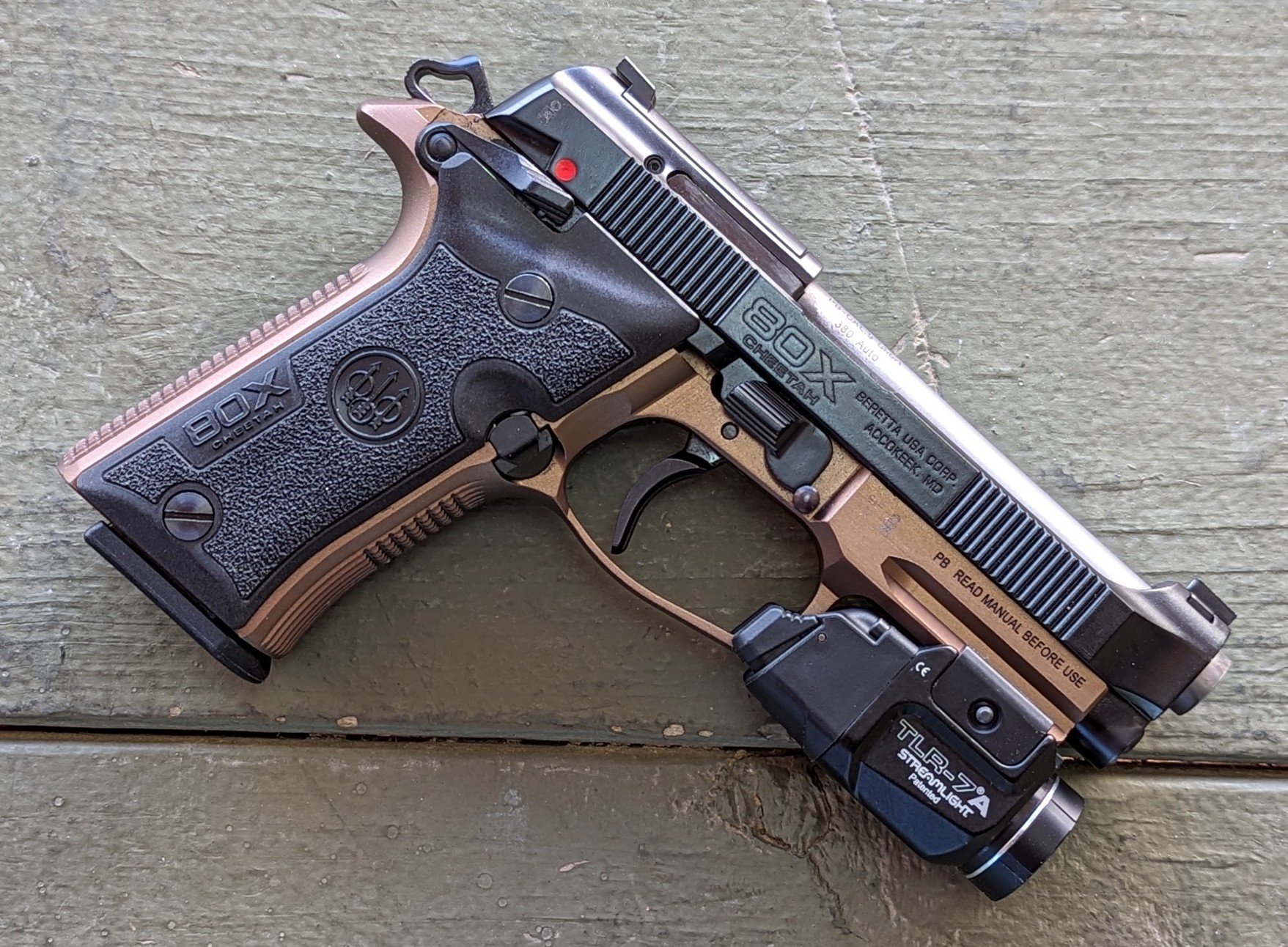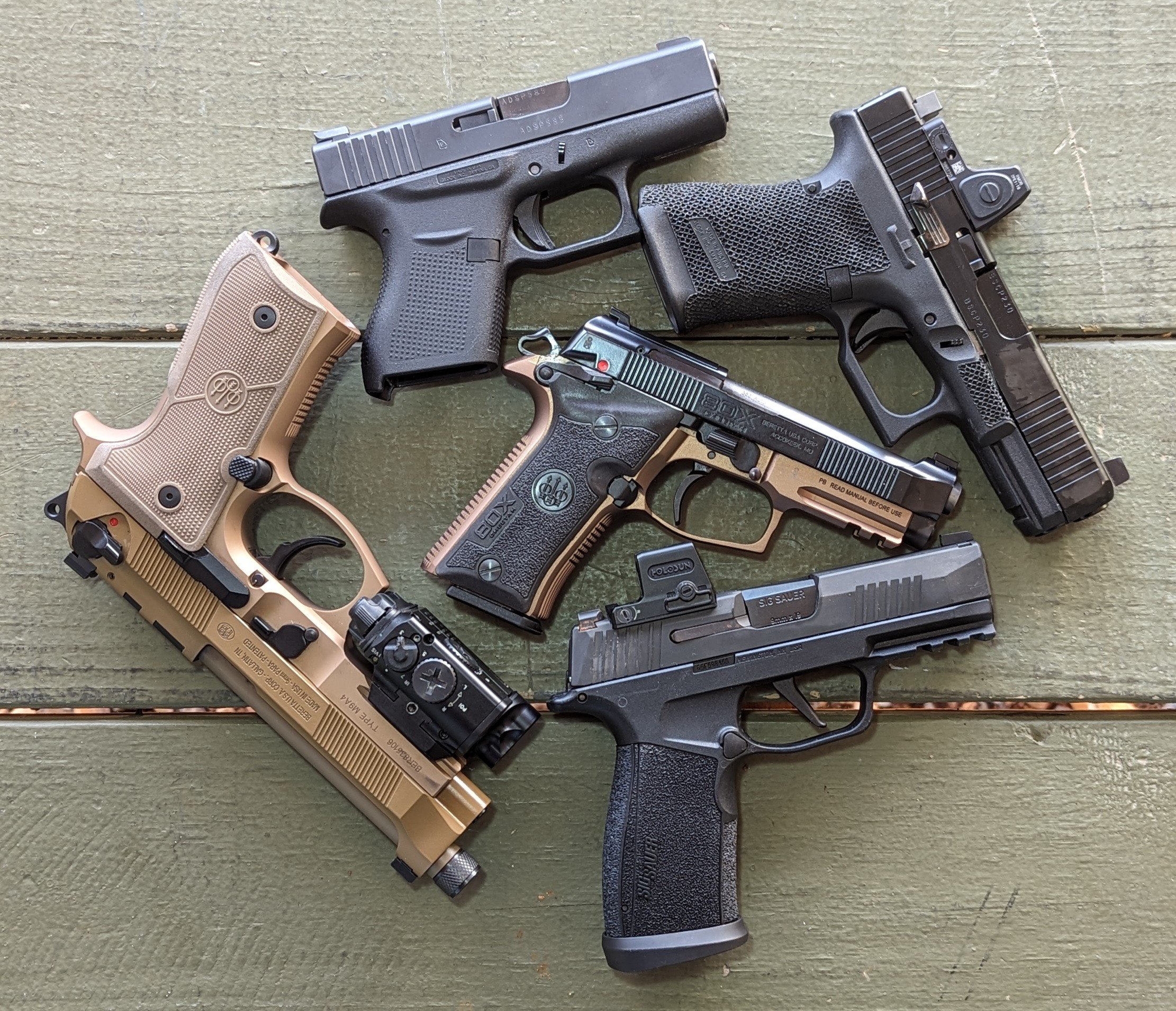Firearms are a constantly evolving technology and have progressed significantly over the last 200 years. The 1911, Hi-Power, and many others are still in prevalent use despite being close to or over 100 years from their original inception. Those classic designs have been refined to improve reliability, functionality, and aesthetics. At this year’s SHOT Show, Beretta introduced a new take on their classic Beretta 80-series design in .380 ACP with the Beretta 80X Cheetah.
For many, a new firearm introduced into the already flooded .380 ACP market is of little merit. It’s just another .380 – and offered on a platform nearing 50 years old. Furthermore, the $800 to $1,000 price tag isn’t exactly the cheapest offering when there are numerous lighter (and smaller) polymer pistols available on the market. I would have been in that category had I not recently had the opportunity to run an 80X through its paces.
In the interest of full disclosure, the 80X Cheetah used for this review was borrowed from Kyle Braschler of The Armorer’s Fix. A huge thank you to him (he purchased the firearm with his own funds) and I highly recommend you check out his YouTube and Instagram pages. Without further ado, let’s delve into the 80X Cheetah and how it performed after more than 300 rounds through it.
Beretta 80X Bronze
The Beretta 80-series Cheetah pistol was first introduced in 1976 and offered chamberings in .22 LR, .32 ACP, and .380 ACP. As popular as double-stack compact pistols in 9mm and .380 are today, the .380 Cheetah was offered with a 13-round magazine in a compact package. Since then, this firearm has proven to be a reliable design that, like the 1911 and Hi-Power, is timeless in its relevance as a concealed carry defensive firearm.
The 80X Cheetah used for this review was Beretta’s first-run “Bronze” collector’s model. While shooting such a collectible is somewhat sinful, this firearm is a tool and one that was intended to be shot – and we did just that. The 80X Bronze arrived in a beautiful presentation collector’s case (a several hundred-dollar upgrade) with two magazines. Upon inspecting the firearm, it was clear Beretta made numerous modern upgrades to this classic design.

The 80X Bronze ($1,000 retail) has a nice tri-tone finish with a black slide, bronze frame, and stainless barrel. Beretta is offering an all-black 80X Cheetah variant that is more palatable to the shooter looking for a more budget-conscious price point ($750-800). It features Beretta’s tried-and-true Vertex grip profile and their X-treme single and double-action trigger. The pistol has many modern features beyond the trigger and grip enhancements including interchangeable sights and an optics-ready slide. These features are simply scraping the surface of the modern upgrades to Beretta’s classic design.
Handling the 80X
The first thing I noted when looking at the 80X Cheetah was the aesthetics. It looks modern and sleek with a classic touch. The upgraded appearance is similar to seeing a modern custom 1911 compared to an original Browning patent 1911. Classic, yet modern and practical.
The pistol features a frame-mounted decocker that is opposite to what many expect from a decocker. For example, the Beretta 92 requires a downward stroke of the decocker to drop the hammer safely. Firearms like the CZ 75, Sig 226, 229, 239, etc have a similar manual of arms on their decockers (albeit in a different location). The Beretta 80X decocker is an upward stroke to drop the hammer. This conveniently prevents accidental decocking of the pistol during firing, manipulation, or stressful conditions. The safety is built into the decocker and functions similarly to a 1911 safety. Unfortunately, the pistol doesn’t currently offer a “cocked-and-locked” feature which would be something I’d like offered from Beretta in the future.
The 80X uses a 13-round magazine of .380 ACP. The magazines fed reliably over 300 rounds with no malfunctions. As a matter of note, the 80X magazines require some break-in. When loading the magazines for the first time, it was difficult to get them past ten rounds. After loading and unloading the magazines several times, they fit all 13 rounds easily. This is not an uncommon issue with high-capacity double-stack compacts. I highly recommend using an UpLula Mag Loader as I took a small chunk of skin out of my finger loading one of the mags for the first time. The sharp edges on the mouth of the magazine can be avoided, along with the physical pain felt, by using a reputable, quality magazine loader.

The 80X is modernized by more than just aesthetics with the addition of an M1913 rail for mounting a light or laser. For part of the testing, I ran a Streamlight TLR-7 mounted on the rail and found the recoil exceptionally soft in a compact metal frame direct-blowback pistol. The light did shift on the rail after repeated recoil, but this was no fault of the firearm as much as it was from not using the correct rail adapter. I preach that the correct tool – and part – for the job is paramount. Sound advice I probably should follow myself.

In addition to modern aesthetics, the 80X is milled for a red dot optic. At the time of this writing, I was unable to obtain a rail to mount an optic to the pistol. However, there is something to be said about keeping this pistol in a somewhat traditional configuration without the optic. The slide profile for the 80X, similar to the venerable Beretta 92 or M9 series, appears to mount the optic somewhat high for a concealed carry pistol. However, I’ll reserve any judgment, praise, or criticism regarding this until I can handle and send some rounds down range on one with an optic.

Range Time on the 80X
The Beretta 80X performed flawlessly on the range. Magazine changes were smooth and clean and the slide release was easy to manipulate. Whether shooting at targets at 7 yards or 40 yards, it was surprisingly easy to get hits on steel. The soft recoil of the .380 cartridge coupled with the compact, yet comfortable, size of the 80X made the pistol exceptionally pleasant to shoot. Over the course of 300 rounds, there were no malfunctions on the 80X.

The slide profile of the 80X, whether intentional or not, performs the task of drawing my eye to the sights easily during presentation. The rapid transition between targets, follow-up shots, and precision shots at distance was easily accomplished. As the brass piled on the range, it was surprisingly easy to accomplish 25-40 yard center mass shots with relatively rapid follow-up shots (.30 to .40 second split times).
There are few iron sight compact .380 pistols on the market I believe that could accomplish such a feat. The trigger is one of the smoothest double-action triggers I’ve ever felt. The reset and follow-up single-action trigger is short and smooth as well. I’m finicky about a gritty trigger and this was noticeably absent from the 80X. Staging the trigger on double-action for precision first shots was effortless.
The 80X’s Role Today
The Beretta 80X is not the concealed carry .380 we think of in the modern sense. There are numerous custom manufacturers that offer modernized versions of a timeless firearm – the 1911. Some designs, regardless of developments in metals and polymers, withstand the test of time. Some of those custom firearm manufacturers offer upgrades to the Beretta 92 series that make it a work of art as well as an even better fighting pistol. Beretta took the lead with the 80X and offered the aesthetics and quality directly from their factory which is commonly reserved only from custom firearm manufacturers.

Compared to many of the other pocket and compact pistol options available today, some may dismiss the 80X as too pricey to justify its purchase. I respectfully disagree, however. The 80X has all the modern features expected of a defensive pistol along with something – status and style.
Yes, you can purchase a reliable .380 for a few hundred dollars, but it likely won’t have the comfort and aesthetic appeal of the 80X. For comparison, a reliable 1911 can be purchased for around $1,000 or less. However, gun buyers are willing to pay factors of three or four beyond that price tag to carry a firearm that is a piece of art as much as it is a capable firearm. As such, I stand by my judgment that Beretta is offering a .380 compact in a reasonable price range considering what some are willing to pay for similar custom firearms.
The Beretta 80X isn’t anything revolutionary, but it is a proven and reliable weapons platform with 50 years of solid performance behind its name. There are no kinks to work out or doubts about its reliability. It works. Beretta took great effort to bring a classic firearm of theirs into the 21st Century while maintaining the visual appeal of the original 80 series. After handling and shooting the 80X, I confidently say Beretta accomplished that feat and then some.


